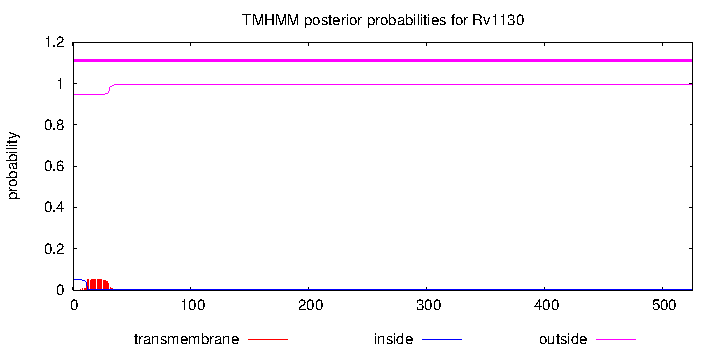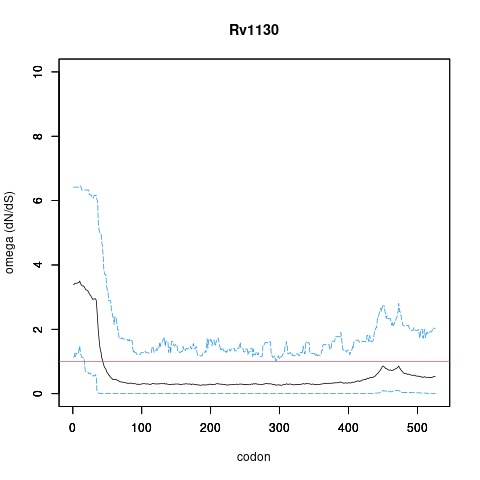| Property | Value | Creator | Evidence | PMID | Comment |
| Interaction | Regulatory Rv1129c | anshula.arora1990 | NAS | | co-expression
X. Pang, P. Vu et al. Evidence for complex interactions of stress-associated regulons in an mprAB deletion mutant of Mycobacterium tuberculosis. Microbiology (Reading, Engl.) 2007 |
| Interaction | Transcription Rv1132 | ashwinigbhat | IDA | | Coexpression (Real Time semiquantitative RT-PCR)
authors,MA. Fisher,BB. Plikaytis,TM. Shinnick Microarray analysis of the Mycobacterium tuberculosis transcriptional response to the acidic conditions found in phagosomes. J. Bacteriol. 2002 |
| Interaction | RegulatedBy Rv0981 | yamir.moreno | IEP | | Microarrays. mRNA levels of regulated element measured and compared between wild-type and trans-element mutation (knockout, over expression etc.) performed by using microarray (or macroarray) experiments..
H. He, R. Hovey et al. MprAB is a stress-responsive two-component system that directly regulates expression of sigma factors SigB and SigE in Mycobacterium tuberculosis. J. Bacteriol. 2006 |
| Interaction | RegulatedBy Rv0757 | yamir.moreno | IEP | | Microarrays. mRNA levels of regulated element measured and compared between wild-type and trans-element mutation (knockout, over expression etc.) performed by using microarray (or macroarray) experiments.. qRT-PCR. mRNA expression levels of regulated element measured and compared between wild-type and trans-element mutation (knockout, over expression etc.) performed by using qRT-PCR technique.
SB. Walters, E. Dubnau et al. The Mycobacterium tuberculosis PhoPR two-component system regulates genes essential for virulence and complex lipid biosynthesis. Mol. Microbiol. 2006 |
| Interaction | RegulatedBy Rv0757 | yamir.moreno | IEP | | Microarrays. mRNA levels of regulated element measured and compared between wild-type and trans-element mutation (knockout, over expression etc.) performed by using microarray (or macroarray) experiments.. qRT-PCR. mRNA expression levels of regulated element measured and compared between wild-type and trans-element mutation (knockout, over expression etc.) performed by using qRT-PCR technique.
SB. Walters, E. Dubnau et al. The Mycobacterium tuberculosis PhoPR two-component system regulates genes essential for virulence and complex lipid biosynthesis. Mol. Microbiol. 2006 |
| Interaction | RegulatedBy Rv1221 | yamir.moreno | TAS | | Literature previously reported link (from Balazsi et al. 2008). Traceable author statement to experimental support.
G. Balzsi, AP. Heath et al. The temporal response of the Mycobacterium tuberculosis gene regulatory network during growth arrest. Mol. Syst. Biol. 2008 |
| Interaction | RegulatedBy Rv2711 | yamir.moreno | IEP | | Microarrays. mRNA levels of regulated element measured and compared between wild-type and trans-element mutation (knockout, over expression etc.) performed by using microarray (or macroarray) experiments..
GM. Rodriguez, MI. Voskuil et al. ideR, An essential gene in mycobacterium tuberculosis: role of IdeR in iron-dependent gene expression, iron metabolism, and oxidative stress response. Infect. Immun. 2002 |
| Citation | Role of the methylcitrate cycle in Mycobacterium tuberculosis metabolism, intracellular growth, and virulence. EJ. Muoz-Elas, AM. Upton et al. Mol. Microbiol. 2006 | jjmcfadden | | 16689789 | Inferred from direct assay |
| Term | EC:4.2.1.79 2-methylcitrate dehydratase. - NR | jjmcfadden | NR | | Inferred from direct assay
EJ. Muoz-Elas, AM. Upton et al. Role of the methylcitrate cycle in Mycobacterium tuberculosis metabolism, intracellular growth, and virulence. Mol. Microbiol. 2006 |
| Term | EC:4.2.1.99 2-methylisocitrate dehydratase. - NR | extern:JZUCKER | NR | | Traceable author statement to experimental support
authors,KY. Rhee,LP. de Carvalho,R. Bryk,S. Ehrt,J. Marrero,SW. Park,D. Schnappinger,A. Venugopal,C. Nathan Central carbon metabolism in Mycobacterium tuberculosis: an unexpected frontier. Trends Microbiol. 2011 |
| Citation | Role of the methylcitrate cycle in Mycobacterium tuberculosis metabolism, intracellular growth, and virulence. EJ. Muoz-Elas, AM. Upton et al. Mol. Microbiol. 2006 | extern:JZUCKER | | 16689789 | Assay of protein purified to homogeneity from its native host |
| Term | EC:4.2.1.79 2-methylcitrate dehydratase. - NR | extern:JZUCKER | NR | | Assay of protein purified to homogeneity from its native host
EJ. Muoz-Elas, AM. Upton et al. Role of the methylcitrate cycle in Mycobacterium tuberculosis metabolism, intracellular growth, and virulence. Mol. Microbiol. 2006 |
| Term | EC:4.2.1.99 2-methylisocitrate dehydratase. - NR | extern:JZUCKER | NR | | Assay of protein purified to homogeneity from its native host
EJ. Muoz-Elas, AM. Upton et al. Role of the methylcitrate cycle in Mycobacterium tuberculosis metabolism, intracellular growth, and virulence. Mol. Microbiol. 2006 |
| Citation | Central carbon metabolism in Mycobacterium tuberculosis: an unexpected frontier. authors,KY. Rhee,LP. de Carvalho,R. Bryk,S. Ehrt,J. Marrero,SW. Park,D. Schnappinger,A. Venugopal,C. Nathan Trends Microbiol. 2011 | extern:JZUCKER | | 21561773 | Traceable author statement to experimental support |
| Term | EC:4.2.1.79 2-methylcitrate dehydratase. - NR | extern:JZUCKER | NR | | Traceable author statement to experimental support
authors,KY. Rhee,LP. de Carvalho,R. Bryk,S. Ehrt,J. Marrero,SW. Park,D. Schnappinger,A. Venugopal,C. Nathan Central carbon metabolism in Mycobacterium tuberculosis: an unexpected frontier. Trends Microbiol. 2011 |


